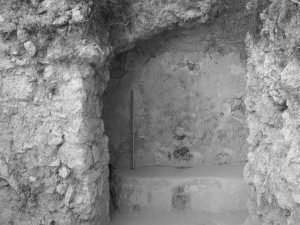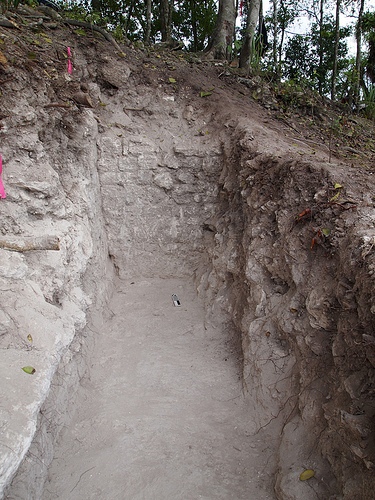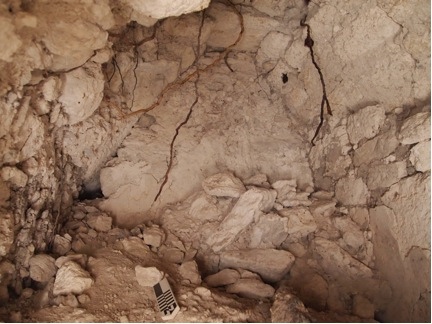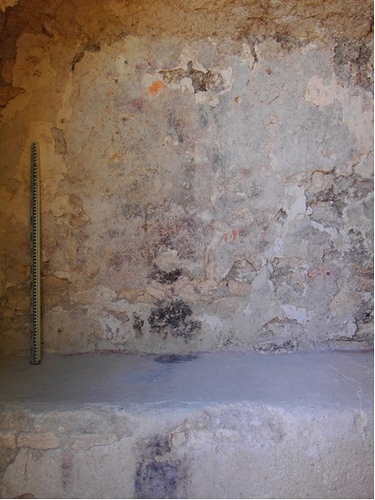
Known as Tulix Mul, it appears at first blush as a mound-like island of jumbled trees and bushes jutting out of a landscape that has been otherwise cleared by local mechanized ranchers for their cattle ranch operations. It is a curious protrusion, but only because this site holds special value to archaeologists and other researchers. The local landowner ranchers have agreed to leave it untouched — at least for now. Going forward, however, there are no guarantees. Development must ultimately meet the needs of developers. In the meantime, investigators are racing against the clock and other elements to excavate, study, and preserve the site. It is an ancient Early Classic (200-600 CE) Maya site in northwestern Belize that contains evidence of at least two standing vaulted rooms.
__________________________________________________________________________________________
View of Tulix Mul from the south. Courtesy Maya Research Program
__________________________________________________________________________________________
As a relatively recent discovery, archaeologists, under the auspices of the Maya Research Program (MRP), and the University of Texas at Tyler, have been excavating at the site since 2012. It has been identified as a shrine group approximately 1 km. from Nojol Nah, another severely endangered Maya center where they have been excavating. In 2013, they focused on a structure (designated “Structure 2” on their site plan) that showed intrusion by a looter’s trench. Excavation revealed evidence of a vaulted room.
“Our goal in 2013 was to strip the final phase of architecture from the eastern facade of this Early Classic structure in order to document its abandonment [in Late Classic times, or 600 – 900 CE] and to penetrate the centerline of the structure *so its various phases of construction could be recorded,” said Colleen Hanratty, a member of the Board of Directors of MRP and a leading, long-time researcher and field archaeologist with the organization. “In addition, a looter’s trench on the western side of the structure was cleared out in order to document the architecture therein. While clearing out the looter’s trench, it was revealed that the vaulted room was intact and had been filled in by the ancient Maya. We could see spots of intact plaster on the walls, which was very exciting. But we had to be patient. We continued to focus our energy on the eastern facade of the structure and soon discovered that it was actually an Early Classic roomblock that apparently had been filled in at the beginning of the Late Classic time period. We carefully removed the construction fill and were thrilled to discover additional plaster adhering to the room’s western wall and bench.”
Discovery of a plastered vaulted room was news enough. But by far the biggest prize was found beneath the plaster. Through time, small fragments had exfoliated from the plaster, revealing underlying evidence of a polychrome, fine-line mural. The mural style appeared generally similar to that found years before by other archaeologists at San Bartolo in Guatemala. Like San Bartolo, there are only a few other known Maya murals found in Central America. Aside from their artistic beauty, each has provided significant new information about Maya art, religious concepts, trade and interaction. The Tulix Mul mural may prove to be equally informative, especially as the site investigators suspect that “there is a real likelihood that the other room [still unexcavated] will also contain a mural.”*
__________________________________________________________________________________________
Above and below, exterior of Structure 2 emerges through painstaking excavation of its eastern side. Courtesy Maya Research Program.
_________________________________________________________________________________________________________________________
__________________________________________________________________________________________
The looters trench on the western side. Courtesy Maya Research Program
_______________________________________________________________________________________________________________________
The vaulted room as it appeared before the fill was removed. Courtesy Maya Research Program
_______________________________________________________________________________________________________________________
Above and below: View into the vaulted room, now excavated, containing the mural (currently still mostly plasted over by the ancients). Courtesy Maya Research Program
__________________________________________________________________________________________
_______________________________________________________________________________________________________________________
For now, not enough of the mural has been exposed to determine what is depicted (see image below). Archaeologists are moving forward with a sense of urgency to ensure that a fuller view of the mural (or murals, as the case may be), will see the light of day. In 2014, the archaeological team, under the professional leadership of Thomas Guderjan of the University of Texas at Tyler, conservator Pieta Greaves of AOC Archaeology, Scotland, and Gail Hammond of University College London, will methodically and painstakingly remove the plaster overcoating from the mural to reveal the rest. Other specialized members of the team will document and interpret the mural as it is exposed. The same will be done for any additional mural finds as the team progresses to uncover the other vaulted room.
__________________________________________________________________________________________
Closeup detail view of mural thus far exposed. Courtesy Maya Research Program
_________________________________________________________________________________________
But the team will be working under a shadow of uncertainty.
“Several threats to the site exist,” says Guderjan. “First, the property is owned by a mechanized farming and ranching concern which often exhibits resistance to legalities. Legal protections exist but may not be followed and enforcement is difficult and generally non-existent until after the fact. Good relations exist today but cannot be guaranteed in the long run. The only solution to this problem is to purchase the site and put it into public hands. Second, the site is remote and therefore looting could occur unseen. Further, it is an obvious mott of trees on the landscape and easily found. There is also risk of damage by casual visitors so physical security of the mural must be achieved. Such security must also take into account the need to protect the mural from environmental degradation.”*
Some good news has brightened the horizon for the site. Recently, the Archaeological Institute of America has approved a generous grant to help conserve and record the site, including the development of an educational outreach program that will benefit not only the visiting public but also members of the local community. In terms of protection and preservation, the team plans to “include the construction of a sealed door enabling the mural to remain in a cave-like controlled temperature and humidity setting that also restricts access from intruders.”*
_____________________
The Long Term: Saving Tulix Mul
The team leadership has been in negotiations to purchase the site, including its larger companion site of Nojol Nah, a medium-sized Late Preclassic (400 BCE-200 CE)/Early Classic(200-600 CE) Maya center that includes evidence of a public precinct with a pyramidal structure, elite residential structures, and numerous burials. The research stakeholders maintain that purchasing the sites will mean greater control of them for preservation, conservation, study, and heritage education, and will decrease the likelihood of impending destruction due to expanding agricultural operations.
To help facilitate these efforts, the MRP, in collaboration with Popular Archaeology Magazine, has launched a fund-raising campaign through the magazine’s Adopt-a-Site program to acquire the necessary funds to purchase up to 100 acres to protect Nojol Nah, its outlying component of Tulix Mul, and other sites in the area.
For interested readers, see the website for more information about the Maya Research Program, and Adopt-a-Site for more information about the donation program.
_________________________
*Interview with Thomas Guderjan and Colleen Hanratty of the Maya Research Program.
_______________________________________________________________________________________________________
Read about the most fascinating discoveries with a premium subscription to Popular Archaeology Magazine. Find out what Popular Archaeology Magazine is all about. AND MORE:
 On the go? Purchase the mobile version of the current issue of Popular Archaeology Magazine here for only $2.99.
On the go? Purchase the mobile version of the current issue of Popular Archaeology Magazine here for only $2.99.
And, Popular Archaeology’s annual Discovery edition is a selection of the best stories published in Popular Archaeology Magazine in past issues, with an emphasis on some of the most significant, groundbreaking, or fascinating discoveries in the fields of archaeology and paleoanthropology and related fields. At least some of the articles have been updated or revised specifically for the Discovery edition. We can confidently say that there is no other single issue of an archaeology-related magazine, paper print or online, that contains as much major feature article content as this one. The latest issue, volume 2, has just been released. Go to the Discovery edition page for more information.
Subscription Price: A very affordable $5.75 for those who are not already premium subscribers of Popular Archaeology Magazine (It is FREE for premium subscribers to Popular Archaeology). Premium subscribers should email [email protected] and request the special coupon code. Or, for the e-Book version, it can be purchased for only $3.99 at Amazon.com.












